Water and Land Ritual paintings
The Water and Land Ritual paintings (水陆画) are a style of traditional Chinese painting based on religious or Chinese mythological subjects. The paintings are mainly intricate portraits of religious deities, historical figures, and the contrasting lives of common people and tragedies, in an ornate style with rich use of vivid colors and patterns. The paintings can encompass a wide range of mediums, including scroll-painting, murals, and even sculptures.[1][2]
Despite its often mythological subject matter, parts of the Water and Land paintings that are dedicated to commoners show a realistic, often downtrodden and tragic view of their everyday lives, as part of the ritual to reflect on the suffering of the deceased.[1] The paintings preserve the intricacies of fashion of the era and gives a greater view of the cultural and spiritual landscape. The visual similarities in the portraits of divine figures with traditional Chinese opera costuming also provide understanding to the mutual inspiration between art forms.[2]
The history of Water and Land Ritual painting can be traced back to the Three Kingdoms period, with other early mentions during the late Tang dynasty,[3] and became popularised in the Yuan, Ming and Qing dynasties as part of the Buddhist Liberation Rite of Water and Land to appease and enshrine spirits of the deceased. While the paintings has its origins in Buddhist rituals, the paintings also include Taoist and Ruist figures as reflection of local folk religious culture.[1][2] Many of the best preserved paintings are from the Ming and Qing dynasties, particularly in Shanxi and Hebei.[3]
Gallery
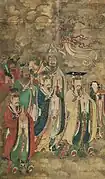 Celestial Emperor and attendants, Ming Dynasty.
Celestial Emperor and attendants, Ming Dynasty.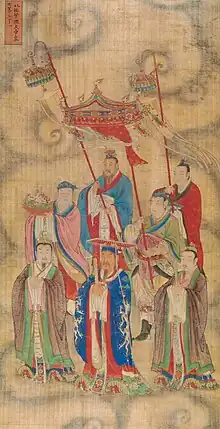 Great Emperor of the North Star, Baoning Temple, Ming Dynasty.
Great Emperor of the North Star, Baoning Temple, Ming Dynasty. Taiyi gods, Baoning Temple, Ming Dynasty.
Taiyi gods, Baoning Temple, Ming Dynasty.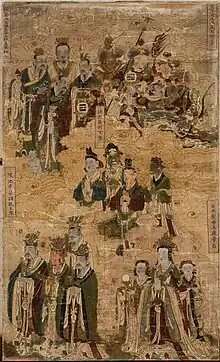 Celestial deities, Ming Dynasty
Celestial deities, Ming Dynasty
![Shangyuan furen [zh] and Houtu](../I/Dame_de_l'Origine_sup%C3%A9rieure_(Shangyuan_furen)_et_l'imp%C3%A9ratrice_de_la_Terre_(Houtu_yuanjun).jpg.webp) Shangyuan furen and Houtu
Shangyuan furen and Houtu Star deities of the northern and central dippers, Ming dynasty
Star deities of the northern and central dippers, Ming dynasty Four Time Guardians (四值功曹)
Four Time Guardians (四值功曹)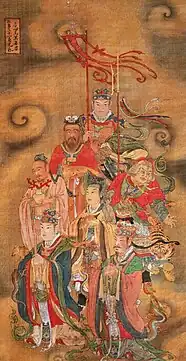 Twenty-Eight Mansions (Azure Dragon), Baoning Temple, Ming Dynasty.
Twenty-Eight Mansions (Azure Dragon), Baoning Temple, Ming Dynasty.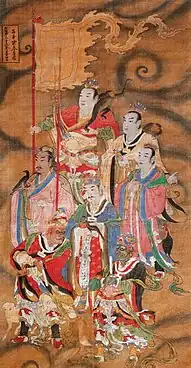 Twenty-Eight Mansions (White Tiger), Baoning Temple, Ming Dynasty.
Twenty-Eight Mansions (White Tiger), Baoning Temple, Ming Dynasty.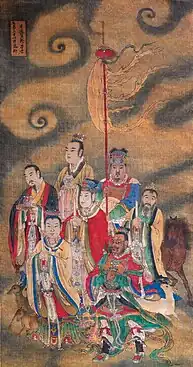 Twenty-Eight Mansions (Vermillion Bird), Baoning Temple, Ming Dynasty.
Twenty-Eight Mansions (Vermillion Bird), Baoning Temple, Ming Dynasty.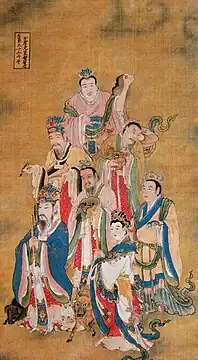 Twenty-Eight Mansions (Black Tortoise), Baoning Temple, Ming Dynasty.
Twenty-Eight Mansions (Black Tortoise), Baoning Temple, Ming Dynasty. Five of the Chinese constellations, Baoning Temple, Ming Dynasty.
Five of the Chinese constellations, Baoning Temple, Ming Dynasty. Generals of the Five Paths, Baoning Temple, Ming Dynasty
Generals of the Five Paths, Baoning Temple, Ming Dynasty Officials and judges of the Earthly Court, Ming dynasty
Officials and judges of the Earthly Court, Ming dynasty Officials of the Earthly Court, Ming Dynasty
Officials of the Earthly Court, Ming Dynasty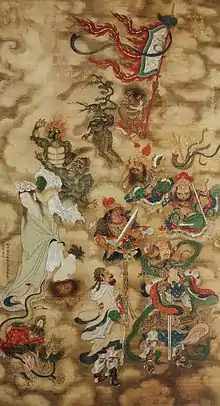 Great Generals of the Desert and the Spirits of Grasses and Trees Who Dwell in the Void of Water and Land, Ming dynasty
Great Generals of the Desert and the Spirits of Grasses and Trees Who Dwell in the Void of Water and Land, Ming dynasty Martyred generals and officials, Baoning Temple, Ming Dynasty.
Martyred generals and officials, Baoning Temple, Ming Dynasty.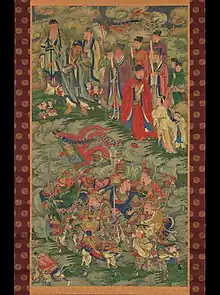 Martyred Generals Who Died for their Country and Officials of Former Times, Ming dynasty
Martyred Generals Who Died for their Country and Officials of Former Times, Ming dynasty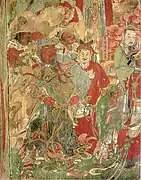 Guan Yu, as seen on mural from Pilu Temple, Shijiazhuang
Guan Yu, as seen on mural from Pilu Temple, Shijiazhuang Officials of Former Times, Ming Dynasty
Officials of Former Times, Ming Dynasty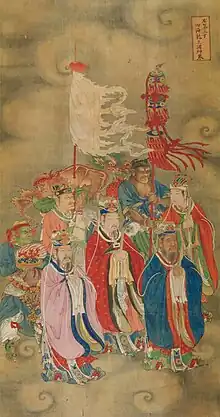 Four Dragon Kings, Baoning Temple, Ming Dynasty.
Four Dragon Kings, Baoning Temple, Ming Dynasty. Water and Land Ritual painting of Canshen and the Five Demons of Pestilence, Baoning Temple, Ming dynasty
Water and Land Ritual painting of Canshen and the Five Demons of Pestilence, Baoning Temple, Ming dynasty Ten Kings of Hell, Ming Dynasty
Ten Kings of Hell, Ming Dynasty Amitabha, Baoning Temple, Ming Dynasty.
Amitabha, Baoning Temple, Ming Dynasty. Guanyin, Baoning Temple, Ming dynasty
Guanyin, Baoning Temple, Ming dynasty Ajita Arya, Baoning Temple, Ming Dynasty.
Ajita Arya, Baoning Temple, Ming Dynasty. Two Luohans, Baoning Temple, Ming Dynasty.
Two Luohans, Baoning Temple, Ming Dynasty. Vajrahāsa, Baoning Temple, Ming Dynasty.
Vajrahāsa, Baoning Temple, Ming Dynasty. Mahabala, Baoning Temple, Ming Dynasty.
Mahabala, Baoning Temple, Ming Dynasty.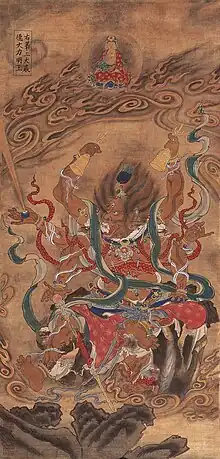 Mahācakra , of the Eight Wisdom Kings, Baoning Temple, Ming Dynasty.
Mahācakra , of the Eight Wisdom Kings, Baoning Temple, Ming Dynasty. Hayagriva, of the Eight Wisdom Kings, Baoning Temple, Ming Dynasty.
Hayagriva, of the Eight Wisdom Kings, Baoning Temple, Ming Dynasty. Kuṇḍali, of the Eight Wisdom Kings, Baoning Temple, Ming Dynasty.
Kuṇḍali, of the Eight Wisdom Kings, Baoning Temple, Ming Dynasty. Aparājita, of the Eight Wisdom Kings, Baoning Temple, Ming Dynasty.
Aparājita, of the Eight Wisdom Kings, Baoning Temple, Ming Dynasty. Yamantaka, of the Eight Wisdom Kings, Baoning Temple, Ming Dynasty.
Yamantaka, of the Eight Wisdom Kings, Baoning Temple, Ming Dynasty. Padanaksipa, of the Eight Wisdom Kings, Baoning Temple, Ming Dynasty.
Padanaksipa, of the Eight Wisdom Kings, Baoning Temple, Ming Dynasty. Trailokyavijaya, of the Eight Wisdom Kings, Baoning Temple, Ming Dynasty.
Trailokyavijaya, of the Eight Wisdom Kings, Baoning Temple, Ming Dynasty. Acala, of the Eight Wisdom Kings, Baoning Temple, Ming Dynasty.
Acala, of the Eight Wisdom Kings, Baoning Temple, Ming Dynasty. Indentured servants and slaves separated from family, Baoning Temple, Ming Dynasty
Indentured servants and slaves separated from family, Baoning Temple, Ming Dynasty Death from miscarriage, severe cold and great heat, Baoning Temple, Ming Dynasty.
Death from miscarriage, severe cold and great heat, Baoning Temple, Ming Dynasty. Death from building collapse, Baoning Temple, Ming Dynasty.
Death from building collapse, Baoning Temple, Ming Dynasty.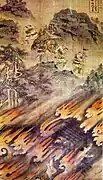 Death from wars and fire, Baoning Temple, Ming Dynasty.
Death from wars and fire, Baoning Temple, Ming Dynasty. Death from starvation, sickness and suicide, Baoning Temple, Ming Dynasty.
Death from starvation, sickness and suicide, Baoning Temple, Ming Dynasty. Death from capital punishment and imprisonement, Baoning Temple, Ming Dynasty
Death from capital punishment and imprisonement, Baoning Temple, Ming Dynasty Death from the wronged, Baoning Temple, Ming Dynasty.
Death from the wronged, Baoning Temple, Ming Dynasty. Lonely ghost, Baoning Temple, Ming Dynasty.
Lonely ghost, Baoning Temple, Ming Dynasty. Scholars and students, Baoning Temple, Ming Dynasty.
Scholars and students, Baoning Temple, Ming Dynasty. Buddhist bhikkuni in waiting, Baoning Temple, Ming Dynasty.
Buddhist bhikkuni in waiting, Baoning Temple, Ming Dynasty. Filial children and grandchildren in waiting, Baoning Temple, Ming Dynasty.
Filial children and grandchildren in waiting, Baoning Temple, Ming Dynasty. Three Officials, Four Saints, and the Great Emperor, Qing dynasty
Three Officials, Four Saints, and the Great Emperor, Qing dynasty Guardians and Deities from the Water-Land Ritual, Qing dynasty
Guardians and Deities from the Water-Land Ritual, Qing dynasty Buddhist, Daoist, and Folk Deities from the Water-Land Ritual, Qing dynasty
Buddhist, Daoist, and Folk Deities from the Water-Land Ritual, Qing dynasty Heavenly and Earthly Deities from the Water-Land Ritual, Qing dynasty
Heavenly and Earthly Deities from the Water-Land Ritual, Qing dynasty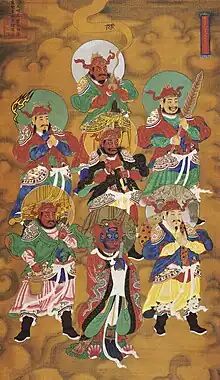 Five Masters of Plague and Ghost and Pestilence King, Qing dynasty
Five Masters of Plague and Ghost and Pestilence King, Qing dynasty Attendees of the Water-Land Ritual, Qing dynasty
Attendees of the Water-Land Ritual, Qing dynasty
References
- Liu Zhongguo 刘忠国 (2011). "浅析中国的水陆画艺术". 现代装饰理论. 09: 91–93.
- 北京文物鉴赏编委会 (2005). 明清水陆画 Paintings for water-and-land service of the Ming and Qing dynasties. Beijing Art Photography Publishing. ISBN 9787805012896.
- Xie Shengbao 谢生保 (2004). "甘肃河西于陆画简介----兼谈才陆法会的起源和发展". 丝绸之路. 01: 8–10.

